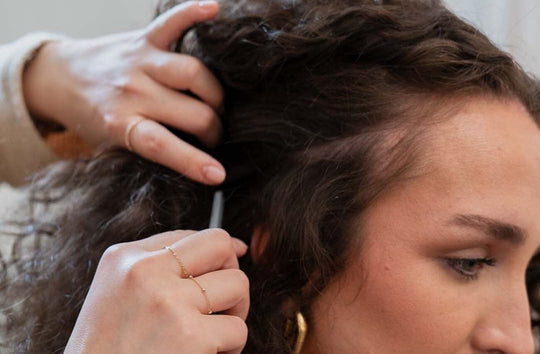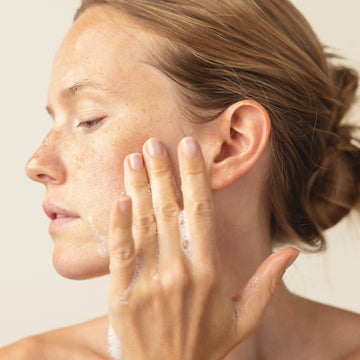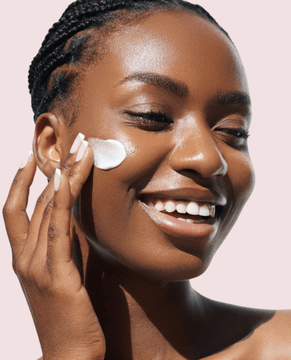The Basics of Sun Protection: SPF, UVA, and UVB Explained

The Basics of Sun Protection: SPF, UVA, and UVB Explained
If skin health is something you take seriously, it’s important to know the basics of sun protection, like how SPF works, the difference between UVA and UVB rays, and the importance of broad spectrum. These terms hold key information about the type and level of protection your sunscreen provides.
Once you know sunscreen terminology, you’ll be able to read product labels with ease and confidently protect your skin from the harmful effects of sun exposure.
Understanding Ultraviolet (UV) Radiation
UV (ultraviolet) light is radiation that comes from the sun. As one of the many forms of radiation, UV is measured on a scientific scale called the electromagnetic (EM) spectrum. Radiation, or EM energy, is made up of tiny particles called photons that travel in a wave-like pattern. The EM spectrum is defined by a range of numbers that represent the photons' energy level and the wavelength's size. UV radiation falls between visible light and X-rays, spanning a range of wavelengths between 10 and 400 nanometers.
UV radiation is able to penetrate the skin's layers changing and often damaging the DNA in skin cells. It has immediate and long-term effects on the skin, including sunburn, tanning, photoaging, and the development of skin cancer.
UVA and UVB Radiation: Differences and Effects
- UVA radiation
- Longer wavelength
- Penetrates deep into the skin’s dermis, contributing to skin aging, wrinkling, and skin cancer.
- Present throughout the day and can penetrate glass and clouds, leading to year-round exposure.
- UVB radiation
- Short wavelength
- Primarily affects the skin's top layer, leading to sunburns and increasing the risk of skin cancer.
- Produces vitamin D in the skin and is the primary source of vitamin D for the body.
- Most intense between 10 a.m. and 4 p.m. and responsible for sunburns.
Broad-spectrum sunscreens protect against both UVA and UVB rays, providing effective and comprehensive defense against sun damage.
The Role of SPF in Sun Protection
You've been using it since you were a kid and always have it stocked during the summer, but what is SPF, exactly?
SPF stands for Sun Protection Factor, a numerical measure of a sunscreen's ability to protect against UVB radiation. It indicates the time it takes for UVB rays to cause sunburn on protected skin compared to unprotected skin. For example, if your skin typically burns after 10 minutes of sun exposure, applying SPF 30 sunscreen would theoretically protect you for 300 minutes, or 5 hours (10 minutes multiplied by SPF 30).
SPF ratings commonly range from 15 to 50+. SPF 15 blocks about 93% of UVB rays, while SPF 30 blocks approximately 97%. SPF 50 provides slightly higher protection, blocking around 98% of UVB rays.
It's important to remember that the incremental increase in protection diminishes as the SPF value increases. Meaning, when the SPF rating is higher than 30, that doesn't mean you can spend more time in the sun without reapplying. Plus, the higher concentrations of sun-filtering chemicals may trigger irritated skin. Therefore, SPF 30 is often recommended as a good balance between protection and practicality.
Sun Protection Products: Types and Ingredients
Wearing a wide brimmed hat and staying cool in the shade is probably the simplest way to protect your skin from the sun. But some activities don’t allow for constant coverage from head to toe.
When you can’t find the shade, that’s when sunscreen becomes paramount. There are two main types of sunscreen, chemical and physical.
- Physical sunscreen (aka mineral)
- Create a barrier on your skin’s surface that reflects UV rays
- Sits on top of your skin and is less likely to clog pores
- Key ingredients: titanium dioxide and zinc oxide
- Chemical sunscreen
- Work by absorbing UV rays before they damage your skin
- Absorbed into the epidermis, which may trigger breakouts in acne-prone or sensitive skin
- Key Ingredients: avobenzone, octinoxate, octisalate, octocrylene, and oxybenzone
Additional Sun Protection Tips
Nothing compares to the protection sunscreen provides against the sun’s UV rays. But you can amp up your line of defense by including these additional proactive measures.
- Physical coverings - hats, umbrellas, and clothing with UPF (ultraviolet protection factor) of 30+ offers protection against UVB and UVA rays.
- Antioxidants - Antioxidants, like vitamin C, help neutralize the damaging free radicals produced by the sun.
- Regular skin checks and dermatologist visits - keep an eye on changes in moles, freckles, or skin growths, and visit your dermatologist annually for skin cancer screenings.
- Avoid mixing - don’t combine SPF with other products, such as foundation or moisturizers, because it would affect its efficacy.
- Apply in the right sequence - physical SPF should be the last step in your skincare routine before you apply makeup, whereas you can use chemical sunscreens first.
- Beware of reflective surfaces - UV rays can bounce off reflective surfaces like water, sand, snow, and concrete, increasing the risk of sunburn. Apply sunscreen more frequently and wear protective gear in these environments.
Best Sun Protection Products for Skin Health
We all know by now that UV rays can cause uncomfortable sunburn, premature skin aging, wrinkles, dark spots, and even skin cancer. And it’s no secret that protecting your skin using sunscreen is the best way to keep your skin healthy.
But we often forget that UV rays can still reach the skin on cloudy days and during winter months. So consistent sun protection throughout the year is key, regardless of the weather conditions. Most weather apps now track the UV index, so you can also monitor when it’s most important to lather up.
Even after learning the basics of sun protection, it can still take time to decipher which SPF is best. You can start by using sun protection products from reputable brands trusted by dermatologists and estheticians. Then, look for a broad-spectrum formula with an SPF 30. Lastly, you can always get an expert opinion by booking a virtual consultation with us.
Recommended sun protection products:




